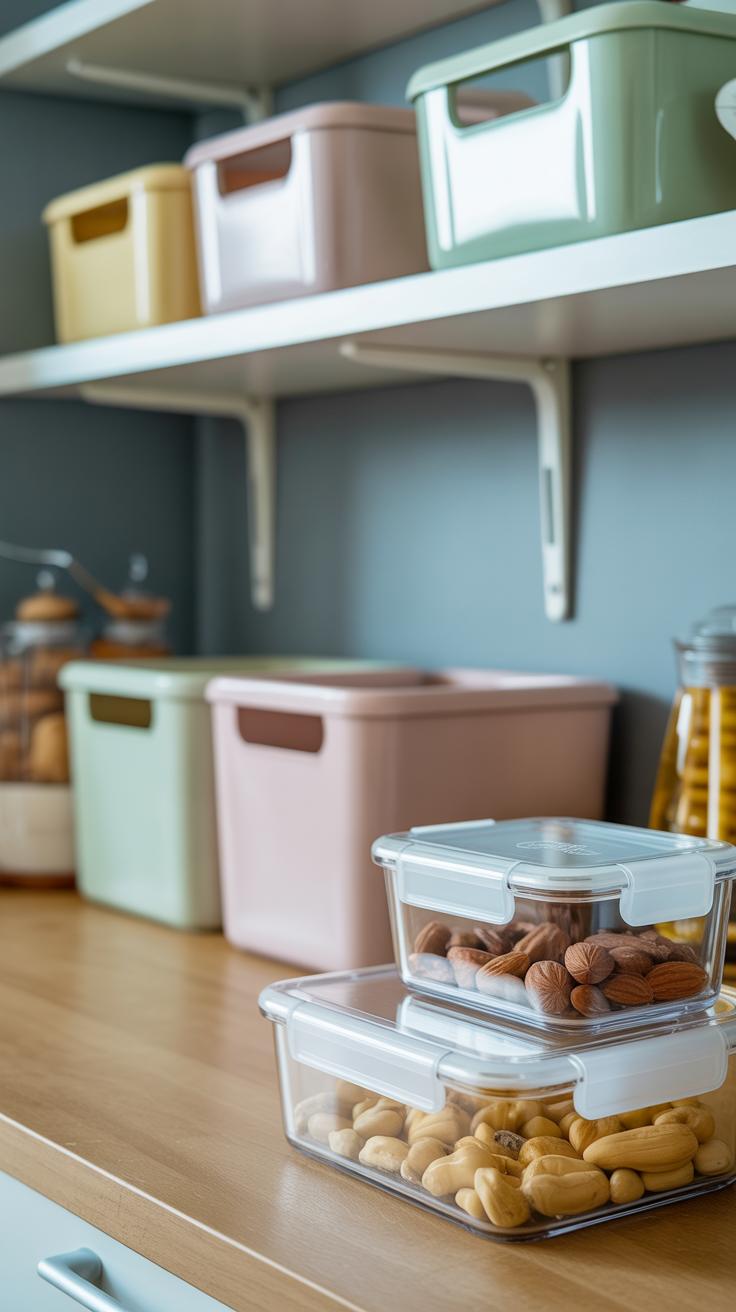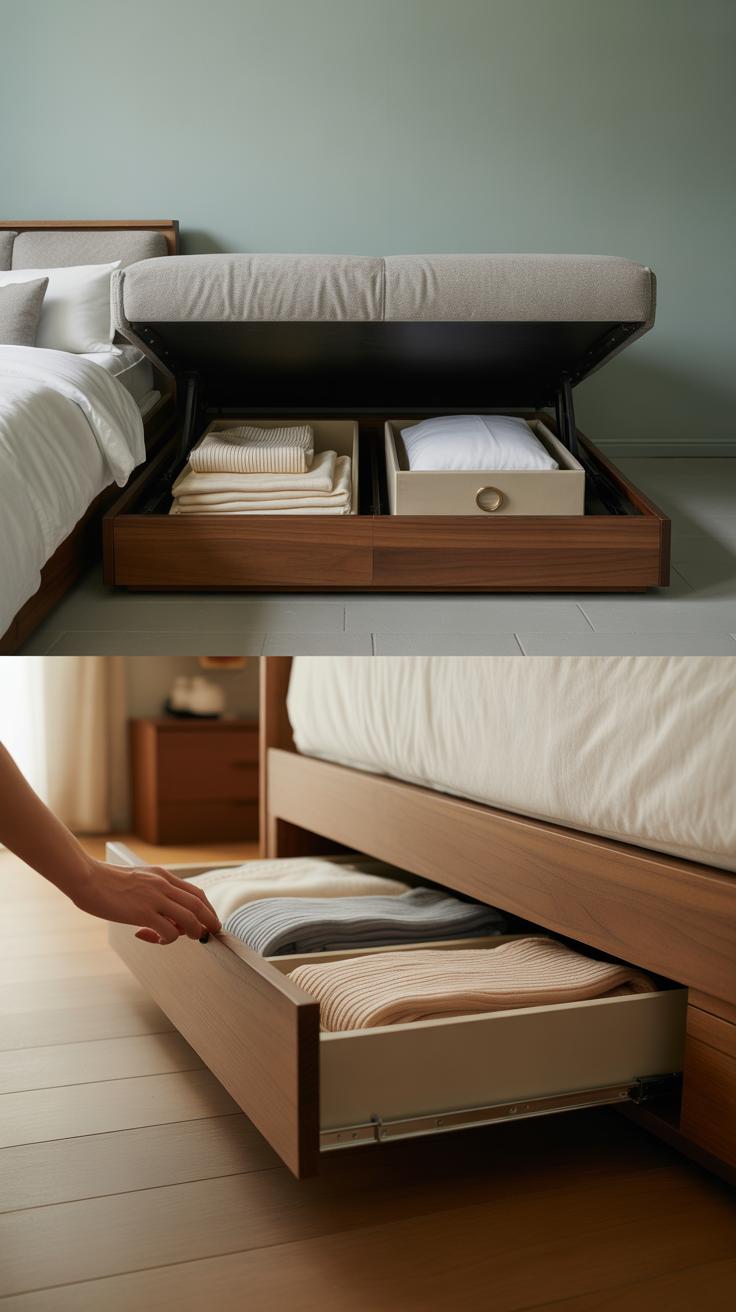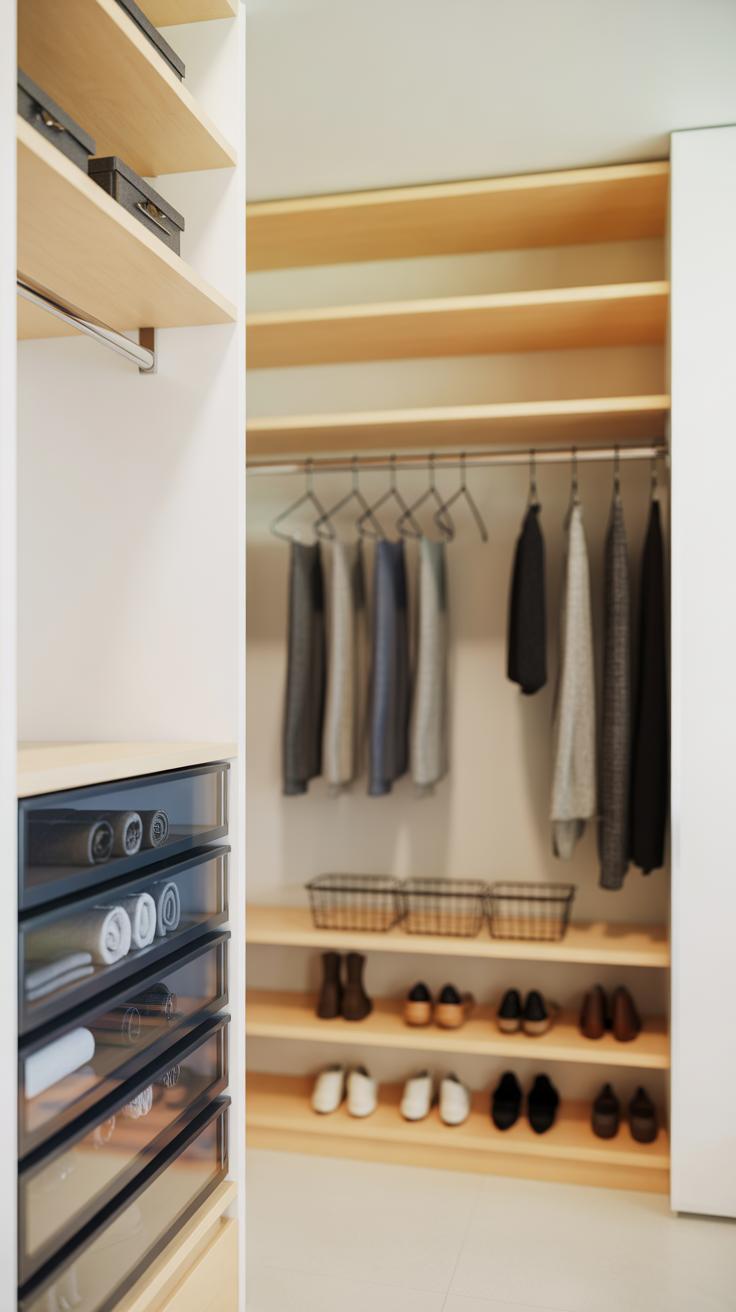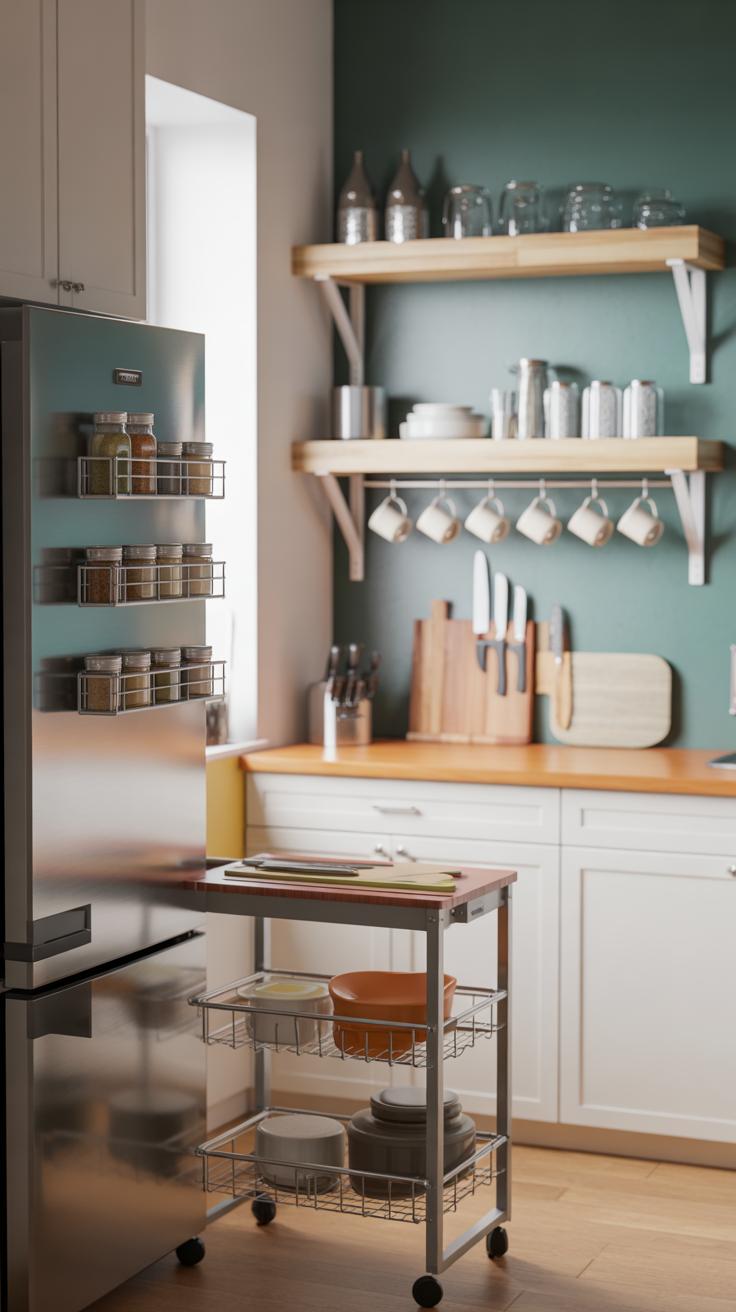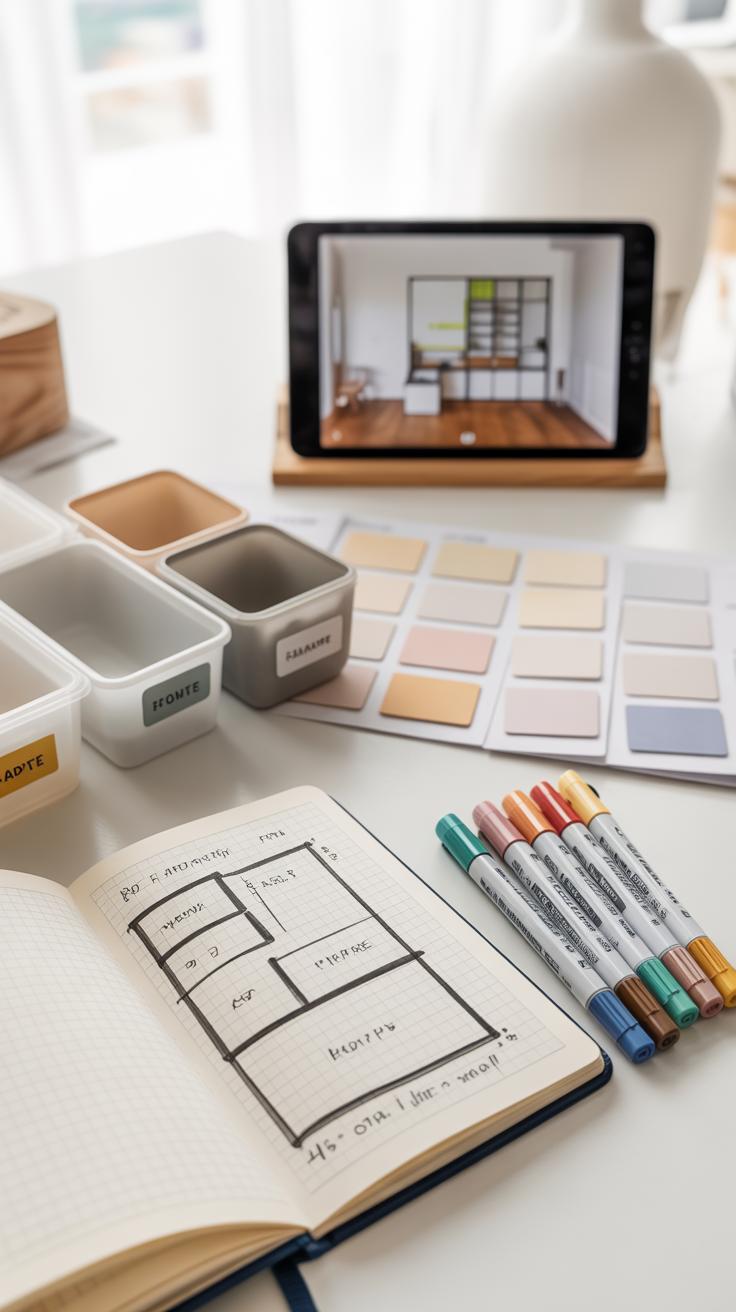Introduction
Living in a small space can feel overwhelming when clutter starts to take over. You might wonder how to keep your room tidy without feeling trapped by limited storage options. The key is to find smart storage ideas that fit your space perfectly.
This article explores a variety of practical and creative storage solutions. These ideas help you declutter any room, making your small space feel more open and organized. You’ll learn how to use your walls, furniture, and hidden spots to store your belongings effectively.
Using Multifunctional Furniture For Extra Storage
Multifunctional furniture can make a big difference when you’re tight on space but still need to keep things organized. Take storage beds, for example. They hide away clothes, bedding, or often bulky items like seasonal gear beneath the mattress. Some have built-in drawers, while others lift up from the base—flipping the mattress or just pulling a lever to reveal the storage below. It’s a subtle way to clear clutter without extra room for dressers.
Ottoman beds work similarly but often add a bit of flexibility, doubling as seating or footrests when closed. They can sometimes feel bulky, so choosing one with clean lines helps maintain an open feeling in the room.
Then, there are coffee tables and end tables that store away magazines, remote controls, or blankets inside. Having storage right where you sit means less chance of things piling up elsewhere. I find sofas with hidden compartments quite handy, too. Cushions lift off to reveal space perfect for toys or even paperwork you don’t want on display but still need close by. Combining seating and storage lets you carry less furniture overall—saving precious floor area.
These pieces don’t just hide items; they keep them accessible and within reach. Maybe you don’t need a bulky chest—just a bed that does more than hold a mattress. Sometimes, the trick is less about adding storage and more about choosing smarter furniture.
Maximizing Vertical Space With Shelves And Hooks
When floor space is tight, looking up can make a big difference. Vertical space often gets overlooked, but it really shouldn’t. You can free up precious ground area by going tall instead of wide, and this approach doesn’t just clear clutter—it makes a room feel more open, oddly enough.
Tall Shelving Units
Tall shelving is a great go-to. Think of those narrow, ceiling-reaching shelves crammed with books, decorative pieces, and storage bins. They take up very little floor area but hold a surprising amount of stuff. I once set up a tall unit in my cramped bedroom. Suddenly, my piles of things had a clear home without spilling onto the floor. Tall shelves create vertical zones for different needs—it’s not just about stacking items; it’s organizing vertically in a way that actually makes things easier to find.
Hooks And Pegboards For Hanging Items
Hooks and pegboards are the unsung heroes in small rooms. You can hang practically anything on a wall—bags, kitchen utensils, headphones, or even indoor plants. It’s an immediate way to clear counters and furniture surfaces. Pegboards offer flexible storage, letting you rearrange hooks as your needs shift. I find it especially handy in kitchens, where hanging tools near the stove can speed up cooking. But that’s not all—you can turn a boring wall into an organized display area, blending function and a bit of style. It makes you wonder why more people don’t rely on walls this way.
Choosing Smart Storage Containers And Organizers
When it comes to small spaces, the right containers can make all the difference. Stackable bins catch my attention first—they help you build upward instead of outward, which is key when floor or shelf space is limited. Clear bins have a subtle advantage too: you see what’s inside without digging around. That saves time and keeps frustration down, especially in closets or cabinets where lighting might not be great.
Picking sizes is a bit tricky but worth some thought. Think about what you actually need to store. For example, a few tall, narrow bins work well for shoes or bottles, while wider, shallow ones suit craft supplies or papers. Mixing sizes isn’t a bad idea; it keeps things flexible. It’s tempting to grab the biggest containers, but that often leads to wasted space or awkward fits.
Stackable And Clear Storage Bins
Stackable bins help reclaim cabinet or closet space you might not realize is wasted. Because they fit neatly on top of each other, you can create layers without things toppling over. Plus, many come with lids, which helps keep dust or pests away—though, lids sometimes make stacking a bit less stable, so you might need to test a few types. Clear bins let you eyeball contents quickly. It’s a small thing, but not having to label or open everything can feel like a little victory in everyday organization.
Drawer Organizers And Dividers
Drawer organizers are lifesavers for small items—maybe pens, kitchen gadgets, or hardware bits. Without them, I find drawers become these jumbled pits where you spend time hunting rather than finding. Dividers break the drawer into zones, which feels nice, like giving everything its own little home. You can buy adjustable dividers to fit different drawer widths or even make simple inserts yourself. It might seem a bit fussier at first, but once you try it, cluttered drawers suddenly don’t stress you out as much.
Making Use Of Hidden Spaces Under Furniture
Under-Bed Storage Options
Spaces under beds often get overlooked, yet they offer a surprisingly large area for storage. Flat storage boxes work really well here. They slide easily beneath the bed frame and keep things out of sight, which is great if clutter makes you anxious. For instance, seasonal clothes like bulky winter sweaters or extra linens can fit neatly into these containers. I’ve found vacuum storage bags handy too, especially when you want to compress bulky items like comforters or off-season jackets. They save space but watch out for the inconvenience of repacking if you access them frequently. Shoes, which tend to scatter around otherwise, can also find a home in divided flat bins. It’s a simple approach, but does it ever feel like these items just keep accumulating? Still, under-bed storage can clear up closet space more than you’d expect.
Using Space Under Sofas And Chairs
The gap beneath sofas and chairs feels like wasted territory, yet hiding storage there isn’t that hard. Small rolling bins or boxes fit well, especially if you want to keep magazines, children’s toys, or remote controls organized but handy. Rolling wheels make access easier—you don’t have to drag heavy furniture to reach what’s stored below. I’ve used low-profile containers with lids there to keep pet toys out of sight while touching them quickly, which was a small relief from constant tidying. You might worry about dust or dirt, but liners or wipeable containers make cleaning manageable. Have you tried fitting storage here before? It almost turns awkward gaps into secret drawers. Though it’s not always perfect, this spot could help you hold onto those everyday items without cluttering tables or shelves.
Organizing Small Closets Efficiently
Small closets can feel like a challenge, right? But with some clever tweaks, you can get a lot more out of that tight space. One simple trick is to add an extra rod below your existing one. This basically doubles your hanging area, especially for shorter items like shirts and pants. It’s surprising how much more you can fit when you stop relying on just one level.
Extra shelves also help, especially if you stack folded clothes, hats, or boxes. Even thin shelves can make a big difference in catching what would otherwise get shoved in a corner. I’m not saying you have to overhaul your closet forever, but a few well-placed shelves can make things way more accessible.
Adding Extra Shelves And Rods
Think of your closet more like a vertical space puzzle. By installing a second clothing rod about 40-45 inches below the top one, you effectively split the hanging space in two. Perfect for dividing long and short garments. You could also squeeze in a shelf above the top rod — sometimes those narrow strips of space get ignored, but they’re great for less-used items.
Sometimes, you might hesitate because it sounds like work, but most shelves and rods are easy enough to add with basic tools or even self-adhesive brackets where drilling isn’t possible. It’s a small project that pays off big time.
Using Hanging Organizers For Accessories
Hanging organizers do neat things for small closets. A hanging shoe rack can clear floor space while keeping your footwear easy to locate. There are also small pouches designed to hang inside the closet door, perfect for scarves, belts, or jewelry. These make it easier to find what you need quickly, so you won’t end up digging around in a pile.
One tip I picked up: be realistic about what you hang. Overstuffing a hanging organizer can make it less effective—sometimes, too many items defeat the purpose. Also, slim hangers take less room and prevent clothes from crowding each other, making the whole closet feel less cramped.
Keeping order is really about routine. Spend just a few minutes regularly tidying your closet, returning things to their spot. It keeps clutter from sneaking back in. So, have you thought about how your closet setup might actually make it harder to stay organized? Sometimes the fix isn’t more space but a smarter way to use what you already have.
Creative Kitchen Storage For Limited Space
Small kitchens often feel cluttered because counter and drawer space vanish quickly. Using magnetic strips for knives can clear up valuable drawer room and keep your sharp tools within easy reach. I once switched to a magnetic strip and noticed how much smoother cooking became—I no longer fumbled through cramped drawers. Plus, wall racks for pots and pans bring bulky items out of cabinets, making everything more visible and accessible. This can be a bit of a trade-off since you’re displaying your cookware, but it often results in a tidier work surface.
Pull-out shelves and baskets inside cabinets tackle the back-of-the-cabinet mystery. Ever had a Tupperware lid or spice jar lost at the back? Pull-out organizers eliminate that struggle by sliding out to reveal what’s hidden. They help keep like items grouped together too, which surprises me every time I try it—things feel more manageable and you’re less likely to buy duplicates.
- Magnetic strips save drawer space and keep knives handy.
- Wall-mounted pot racks clear cabinets and improve accessibility.
- Pull-out shelves and baskets make deep cabinets easier to navigate.
So, could these simple fixes change how your kitchen feels? It’s worth experimenting—clearing countertops just might feel more achievable than you think. After all, small does not need to mean cramped.
Using Wardrobe Doors And Walls For Storage
When space is tight, the backs of your wardrobe doors and empty walls can become unexpected storage goldmines. You might not have thought about these spots much before, but they’re perfect for adding storage without eating into your floor space. Think hooks, racks, and organizers hanging just out of sight. It’s surprising how much you can fit in those narrow areas once you start looking closely.
Over-The-Door Organizers
Over-the-door organizers are a simple fix that can make a noticeable difference. You could hang a shoe rack there to free up closet or floor space. Or maybe a jewelry holder — perfect if your dresser is already overflowing. Some organizers even come with bins or pockets, which helps sort smaller items like scarves, belts, or even cleaning supplies. I’ve used these myself for months, and it’s kind of crazy how much clutter just disappears from sight.
- Shoe racks keep footwear tidy and accessible.
- Jewelry holders prevent tangles and save drawer space.
- Hanging bins can hold random items you otherwise lose track of.
Wall-Mounted Storage Pockets
Wall-mounted pockets, usually made of fabric, are another clever option. They’re great for stashing daily essentials like mail, keys, or even your phone charger — small things that can otherwise clutter surfaces. Alternatively, shallow shelves on the wall offer a spot for small plants, books, or personal care items without taking up precious counters or dresser tops. If you’re like me, you might be wary of adding things to walls because of damage, but many options mount with simple adhesive strips, so no drilling needed.
- Fabric pockets keep frequently used items visible yet contained.
- Shallow shelves provide discreet storage that doesn’t crowd surfaces.
- Adhesive hooks and strips avoid permanent wall damage.
It’s easy to overlook these spaces, but making good use of doors and walls can change how you live in a small room. You might find that small adjustments like these reduce the day-to-day clutter more than you expect. What could you hang on your walls or doors right now? Give it a try; you may be surprised by how much extra space you discover.
Decluttering Regularly To Maintain Order
Keeping storage systems useful means more than just setting them up once. Regular decluttering plays a key role in making sure your space doesn’t quickly become chaotic again. It’s easy to let clutter build up, especially in small spaces where every inch counts. So, dedicating time to sort through your belongings can actually help your storage solutions stay practical and relevant.
Sorting And Donating Items
When you sort through what you own, try grouping items by frequency of use or category—clothes, books, kitchenware, and so on. This makes it clearer what really needs to stay and what doesn’t. You might be surprised by how many things you’ve kept “just in case” but never actually use. Donating those unneeded items can instantly free up space and also benefit others. I once found half the stuff in my closet that I hadn’t touched in years; giving it away felt like shedding unnecessary weight, and the extra room was a welcome bonus.
Creating A Routine For Tidying
Daily habits don’t have to be a chore to keep your small space orderly. Something simple like a 10-minute tidy-up before bed can make a surprisingly big difference. Set a timer, and just focus on returning things to their spots or removing anything out of place. You don’t have to overhaul the whole room each time, just keep on top of the mess so it doesn’t pile up. Over time, this little routine turns into a habit that keeps your storage working instead of hiding clutter under piles.
Building A Personalized Storage Plan
Assessing Your Space And Needs
Start by taking a close look at your room. Where does clutter tend to pile up? Maybe it’s that corner by the door, or perhaps the tops of tables and dressers. Identifying these spots gives you clues about what kind of storage could help. Are you dealing mostly with clothes, books, kitchenware, or random odds and ends? Each calls for different solutions.
Think about how you use the space daily. Do you need quick access to things, or can some items be tucked away? Size matters too—ignoring awkward corners or narrow walls, which people often do, wastes potential. Sometimes, that little nook might fit a custom shelf or a slim cabinet better than a bulky dresser.
Ask yourself: What items really deserve easy reach? What could go into less visible containers? If you live with others, their storage needs matter, too. Gathering all these details helps steer your plan away from guesswork. You might feel a bit overwhelmed, but breaking it down room-by-room makes it manageable.
Mixing And Matching Storage Ideas
Combining storage types often works better than sticking to just one method. For instance, a bed frame with built-in drawers can clear floor space and hide away seldom-used clothes. Meanwhile, wall shelves can hold books or decorative baskets, freeing up table space without crowding the floor.
Containers and boxes play a big role, though the key is picking ones that suit your style and space. Clear bins show contents instantly, but woven baskets add warmth and hide clutter smoothly. It’s tempting to lean heavily on one style; don’t. Mixing open and closed storage gives you flexibility.
Vertical space is your friend, even in a small room. Tall shelving units or hooks on doors can keep items off the floor yet within reach. You might find that combining a hanging organizer with a compact dresser really matches your habits. You want your storage to feel natural, not forced. Experimenting a bit is part of finding the right balance.
Conclusions
Small spaces do not have to limit your storage options. With thoughtful planning, you can transform your room into a well-organized and clutter-free area. Using multifunctional furniture, vertical storage, and creative organizing tricks can make a big difference.
Remember, the goal is to keep things simple and functional. By applying these storage ideas, you can enjoy a more comfortable living space that meets your needs. Start small, stay consistent, and watch your small space become a model of order and style.






